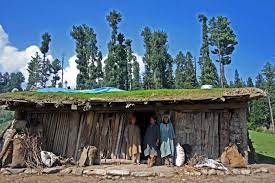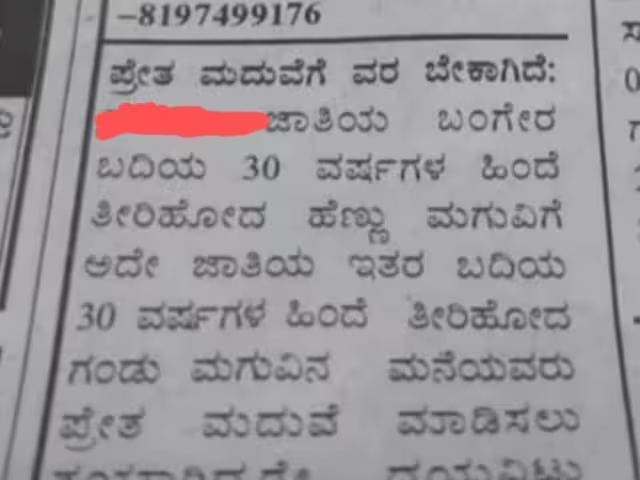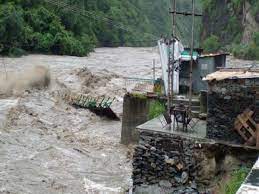Gujjars vs. Paharis: Increasing Support for Bill to Expand Jammu and Kashmir’s SC and ST Lists
The current proposal by the government to include Paharis, a linguistic group, on the Scheduled Tribe list, would be a death knell for Gujjar advancement in Jammu and Kashmir, according to 64-year-old Mohammad Ashraf Poswal of the Tangdhar border region. Poswal traveled from Shamspora hamlet in Tangdhar, some 152 kilometers north of Srinagar, to make his protest last week. Poswal claims that he is the sole former government employee still living in his community. I started working for the department of education in the 1980s and retired four years ago. There isn’t another worker from our community, and there won’t be any more either, adds Poswal. He feels that if the Paharis are added to the Scheduled Tribe, his four children would not have a chance since they cannot compete with the Paharis. “My kids attended public schools and universities to study. The greatest education is provided to Pahari youngsters, who attend prestigious institutions in Jammu and Srinagar, the man said.
During the current session, the Union government proposed the Constitution (Jammu and Kashmir) Scheduled Tribes Order (Amendment) Bill, 2023. The Paharis Ethnic Group will be designated as a Scheduled Tribe, along with three other ethnic groups in Jammu and Kashmir: the Paaddi Tribe, the Gadda Barahmin, and the Koli tribe.
Gujjars’ resistance to include Pahari
Paharis are denied tribal status by Gujjars. They assert that if they are given ST classification, Gujjars would suffer and be thrown into an unending cycle of poverty since the bulk of them are upper caste Muslims, Hindus, and Sikhs who have maintained their position as the ruling class. Gujjars urge that the government reverse the measure in their rallies.
Gujjars would not tolerate this persecution, said Fatima Farooq, the chairman of the Block Development Council from Jammu’s Doda area, during one of these demonstrations. “I want to tell the Indian government that, even at the height of militancy, the tribal community has always made sacrifices for the tricolor. You accuse us of yelling anti-national chants today when we’re just trying to defend our rights, she added. She said that Gujjar activists and leaders who are resisting the law may be detained. “But we are not afraid,” she said. She invited prominent Gujjar figures to join the movement that Gujjar figures in Jammu and Kashmir had initiated. According to a student leader, if Paharis are accorded Scheduled Tribe status, it would lead to further problems.
Former ministers Mian Altaf Ahmad Larvi (National Conference), Chowdhary Zulfikar Ali, and Aijaz Ahmad Khan, as well as former J&K Legislative Assembly deputy chairman Choudhary Javed Ahmad Rana (NC), former legislator Choudhary Qamar Hussain (Apni Party), and former MLA Choudhary Mohammad Akram Lassanvi, released a joint statement on July 31. They all asked the federal government to become involved in resolving the issue that is the subject of the ongoing protests in J&K.
“The widespread Gujjar-Bakerwal protests and the community unrest in the Union territory of J&K are grave developments,” said the speaker. We are quite disturbed and completely perplexed by the current scenario, and the Gujjar-Bakerwal tribe’s protests against the Union Government and the UT administration are an abnormality. The Gujjar-Bakerwal tribe has real concerns regarding their rights and welfare, and we would want to appeal to and implore the Union government and the UT administration to truly and aggressively engage with and resolve those issues. In a joint statement, the leaders stated, “We also want the Union government to reach participatory decisions on delicate topics that might disrupt intercommunity ties in J&K.
Gujjar activist Zahid Parwaz Choudhary claims that there are several castes within the Pahari tribe and that if the law is enacted, 300 additional castes would be added to the list of tribal groups in J&K. “Kashmiri Muslims, Dogra Hindus, Sikhs, Pahari speaking people, and the Pahari group all belong to the same caste. Even the languages of Pahari and Dogri have a common ancestor. The Gujjar, Bakerwal, Gaddi, Sippi, and Dard Tribes would suffer as a result of the bill’s conversion of the whole J&K into a tribal state, he continues.
The Gujjar and Bakarwal pastoralist populations are dispersed across Jammu and Kashmir. However, districts like Rajouri, Poonch, Anantnag, Reasi, Ganderbal, Bandipora, Udhampur, Jammu, Kulgam, Shopian, and other places have the highest concentrations of them.
Twelve ethnicities were formally recognized as scheduled tribes under the Jammu and Kashmir constitution in 1989. In 1989, scheduled tribal status was conferred to eight of these communities: Balti, Beda, Bot, Brookpa, Changpa, Garra, Mon, and Purigpa. The remaining four groups—the Bakarwals, Gujjars, Gaddis, and Sippis—were added to the list of scheduled tribes in 1991 in accordance with the constitution.
statements from commissions
The Gujjar-Bakerwal community’s designation as Scheduled Tribes in 1991 was a major milestone and came about after a protracted fight, said tribal researcher for J&K, Javaid Rahi. He claims that this accomplishment came as a result of findings from several commissions, beginning with the 1953-established Kakasahib Kalekar Commission. According to this commission, there are 837 “most backward” castes in India, including the “Gujjars,” who work as cowherds and graziers and are considered to be disadvantaged in several states, including J&K.
The Jammu and Kashmiri government established the Gajendra Gadkar Commission in 1967 to count the lower social groups. In its 1968 report, Gujjar-Bakerwals was included. Under the heading of socially and economically disadvantaged sections, the Justice JN Wazir Committee in 1969 and the Anand Committee in 1976 argued for a 4% quota for Gujjars-Bakarwals. In 1979, the Mandal Commission recognized Gujjars and Bakerwals as socially and economically disadvantaged castes in Jammu and Kashmir who deserved affirmative action.
On the basis of these suggestions, the Indian government designated the “Gujjars and Bakarwals” as Scheduled Tribes of India on April 19, 1991. They were then given 10% of the population as reservations in 1996. He continues, “The federal government’s choice to empower the Gujjars/Bakerwals group in J&K was a historic act.
The controversy has now arisen as a result of the government’s introduction of a bill to add the “Gadda Brahman,” “koli,” “Paddari Tribe,” and “Pahari Ethnic Group” populations to the list of Scheduled Tribes (STs) in J&K. One of the four bills pertaining to the Union Territory presented in the Lok Sabha, the Constitution (Jammu and Kashmir) Scheduled Tribes Order (Amendment) Bill, 2023, is drawing opposition from Gujjars since it includes Paharis. Gujjars contend that no census taken in J&K has acknowledged Paharis as an ethnic group or Pahari caste. They claim to be upper caste Muslims, upper caste Hindus, upper caste Sikhs, and members of a linguistic group rather than a tribe. The conclusions of the Prof. Amin Peerzada Committee are the basis for the current draft to include the Paharis as the ST.
Identity in Pahari culture and reasons for inclusion
The Paharis’ ST status was backed by a study Prof. Amin Peerzada of Kashmir University was commissioned to do in 2012–2013 for the J&K government. According to Peerzada’s report, “The Pahari language has been acknowledged in the sixth schedule of the Jammu and Kashmir constitution. According to George Grierson’s “Linguistic Survey of India,” it is a dialectal branch of the Indo-Aryan family of languages. Muslim, Hindu, and Sikh speakers all speak Pahari, which is a language of many different religions. The locals are worried about maintaining their culture, especially their language, which they see as a badge of honor and a defining characteristic of their identity.
The Pahari Speaking People are impoverished economically, and their economy is based mostly on subsistence agriculture and other related industries like cow husbandry, which gives them their pastoral and nomadic character. The state’s Pahari-speaking population suffers from a high rate of unemployment due to a lack of infrastructure and business opportunities. The study also said that the Pahari group began working for Scheduled Tribe Status in 1975 and that their efforts intensified in 1991 when the State of Gujarat granted Scheduled Tribe Status to the Gujjar-Bakkarwals. Due to identity issues, the Pahari community became very aware of this and started a full-fledged push to get the aforementioned preferential treatment.
The Pahari-speaking population is dispersed geographically over the State. However, their main concentrations can be found in Poonch, Rajouri, Baramulla, and Kupwara, which are all in the Pir-Panchal range’s foothills. In addition to these four main pockets, their settlements may also be found in the districts of Anantnag, Kulgam, Shopian, Pulwama, Budgam, Ganderbal, and Bandipora. The Paharis eventually received a 4% reservation in employment and educational institutions in 2020, despite the fact that their demand was first denied.
The Justice (retd) G.D. Sharma commission was established later in 2019 to identify socially, educationally, and economically disadvantaged populations. The panel proposed altering the name of the ethnic group known as Pahari Speaking People to Pahari Ethnic Group in its report. Also suggested by the commission were the inclusion of the Gadda Brahmins, Kolis, Paddari, and Pahari ethnic groups on the J&K ST list.
Gujjar leaders organized a Pad Yatra (Protest March) in November of last year to show their opposition to Pahari Speaking People being included to the ST list. They were then summoned to New Delhi, where on November 24, 2023, the Home Minister met with Dr. Javaid Rahi and a group of J&K Gujjars. He writes, “Union Home Minister Amit Shah addressed leaders of the agitated Joint Action Committee after the protest march by the Gujjars and Bakerwals youth over the Central Government’s decision to award Scheduled Tribe status to the Pahari Speaking People. Despite the fact that I wasn’t an agitator, the tribal elders of the Gujjar community assigned me to lead them as a team. The Home Minister promised us at the meeting that the current quota would not be reduced, and he also mentioned additional ST advantages for the Gujjar group. According to the Home Minister’s response to our request, the community’s current 10% reserve would be maintained, and the Pahari Speaking People will be housed in a distinct block as a Scheduled Tribe. I accordingly notified the Gujjar people, and after receiving the Home Minister’s promise, the march was called off.
But now, he continues, “Gujjars have restarted the agitation against ST Status for Pahari Speaking People.” Rahi claims that Gujjars think this problem goes beyond the 10% reservation since it puts Gujjar identity at risk and makes institutions created over time for Gujjars available to non-tribals.
According to journalist and novelist Zafar Choudhary, the political focus on the bill to add Pahari-speaking people to the list of Scheduled Tribes is like to focusing on trees instead of the forest. “Overexcitement among Paharis and rage among Gujjars have obscured the whole problem. In reality, the administration is recasting social and political realities across Jammu and Kashmir as a strategy that is inextricably tied to a wider process of change resulting from Constitutional revisions in August 2019,” he says.
The ST for Paharis is a part of a larger restructuring of social identities that includes about a dozen and a half communities by extending the scope of reservation under ST, SC, and bringing in a number of communities under the OBC, according to Choudhary, the highly acclaimed author of the book Kashmir Conflict and Muslims of Jammu. The current J&K-specific reserved categories RBA, ALC, and OSC will be impacted by this. Since all reservations must be packed within 50%, the RBA, ALC, and OSC quotas will soon change. This implies that the concentration of established beneficiaries may move from established places to more recent locations and communities,” the author continues.







